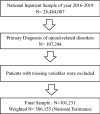Healthcare Utilization of Patients with Opioid Use Disorder in US Hospitals from 2016 to 2019: Focusing on Racial and Regional Variances
- PMID: 36001256
- PMCID: PMC9399995
- DOI: 10.1007/s40261-022-01192-0
Healthcare Utilization of Patients with Opioid Use Disorder in US Hospitals from 2016 to 2019: Focusing on Racial and Regional Variances
Abstract
Background: There is a lack of US population-based research on healthcare utilization differences caused by opioid misuse.
Objective: The aim of this study was to explore disparities in healthcare utilization by type of opioid use disorder, race, region, and other patient factors for a more targeted prevention and treatment program.
Methods: The National Inpatient Sample of the United States was used to identify patients with opioid use disorder (n = 101,231, weighted n = 506,155) from 2016 to 2019. Type of opioid use disorder was defined as opioid dependence/unspecified use, adverse effects of opioids, opioid misuse, and opioid poisoning (also known as overdose). We examined the sample characteristics and the association between type of disorder, racial and regional variables, and healthcare utilization, measured by hospital charges and length of stay. The multivariate survey linear regression model was used.
Results: Among 506,155 patients, most were categorized as opioid dependence/unspecified use (56.3%) and opioid poisoning (42.7%). The number of opioid use disorder patients during the study decreased; however, overall total charges and length of stay continuously increased. Survey linear results showed that opioid poisoning, adverse effects, and abuse were associated with higher hospital charges than opioid dependence; however, length of stay was significantly lower for these groups. White patients compared with minorities, and West, Northeast, and South regions were associated with higher hospital charges and length of stay.
Conclusion: Significant differences in healthcare utilization exist between type of disorder, race, and region. Such findings illustrate that tailored treatment regimens are required to bridge the gaps in care and combat the opioid crisis. Minorities with opioid use disorder utilize healthcare the least, possibly because of affordability, and need culturally sensitive and financially feasible treatment options.
© 2022. The Author(s), under exclusive licence to Springer Nature Switzerland AG.
Conflict of interest statement
Sun Jung Kim, Mar Medina, and Jongwha Chang declare no conflicts of interest.
Figures
Similar articles
-
Does Opioid Use Disorder Matter for Health Care Utilization Among Lung Cancer Patients? Evidence from U.S. Hospitals During 2016-2020.Clin Drug Investig. 2023 Aug;43(8):635-642. doi: 10.1007/s40261-023-01297-0. Epub 2023 Aug 4. Clin Drug Investig. 2023. PMID: 37540484
-
Racial disparity and regional variance in healthcare utilization among patients with lung cancer in US hospitals during 2016-2019.Arch Public Health. 2023 Aug 17;81(1):150. doi: 10.1186/s13690-023-01166-4. Arch Public Health. 2023. PMID: 37592366 Free PMC article.
-
Treatment utilization among persons with opioid use disorder in the United States.Drug Alcohol Depend. 2016 Dec 1;169:117-127. doi: 10.1016/j.drugalcdep.2016.10.015. Epub 2016 Oct 19. Drug Alcohol Depend. 2016. PMID: 27810654 Free PMC article.
-
Opioid analgesic dose and the risk of misuse, overdose, and death: A narrative review.Pharmacoepidemiol Drug Saf. 2018 May;27(5):464-472. doi: 10.1002/pds.4366. Epub 2017 Dec 15. Pharmacoepidemiol Drug Saf. 2018. PMID: 29243305 Review.
-
Risk Factors for Opioid-Use Disorder and Overdose.Anesth Analg. 2017 Nov;125(5):1741-1748. doi: 10.1213/ANE.0000000000002496. Anesth Analg. 2017. PMID: 29049118 Review.
Cited by
-
"I wouldn't need Narcan for myself, but I can have it for somebody else:" perceptions of harm reduction among hospitalized patients with OUD.Addict Sci Clin Pract. 2023 Jun 24;18(1):41. doi: 10.1186/s13722-023-00395-w. Addict Sci Clin Pract. 2023. PMID: 37355639 Free PMC article.
-
Enhancing Outcomes in Opioid Use Disorder Treatment: An Economic Evaluation of Improving Medication Adherence for Buprenorphine Through Blister-Packaging.Subst Abuse Rehabil. 2024 Oct 22;15:209-222. doi: 10.2147/SAR.S484831. eCollection 2024. Subst Abuse Rehabil. 2024. PMID: 39463862 Free PMC article.
-
Does Opioid Use Disorder Matter for Health Care Utilization Among Lung Cancer Patients? Evidence from U.S. Hospitals During 2016-2020.Clin Drug Investig. 2023 Aug;43(8):635-642. doi: 10.1007/s40261-023-01297-0. Epub 2023 Aug 4. Clin Drug Investig. 2023. PMID: 37540484
-
Hospital and physician-based mental healthcare during 12 months of opioid agonist treatment for opioid use disorder: Exploring costs and factors associated with acute care.PLoS One. 2025 Jan 8;20(1):e0314296. doi: 10.1371/journal.pone.0314296. eCollection 2025. PLoS One. 2025. PMID: 39775273 Free PMC article.
References
MeSH terms
Substances
Grants and funding
LinkOut - more resources
Full Text Sources
Medical


